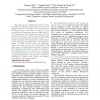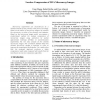CSB
2005
IEEE
14 years 5 months ago
2005
IEEE
CSB
2005
IEEE
14 years 5 months ago
2005
IEEE
Peptide compositions constructed out of whole sets of protein sequences can be used as species signatures for phylogenetic analysis. To account for point mutations, an amino acid ...
CSB
2005
IEEE
14 years 5 months ago
2005
IEEE
The availability of entire genome sequences, coupled with genome-wide studies of gene expression, offers promise for discovering new pathways along with their regulatory programs....
CSB
2005
IEEE
14 years 5 months ago
2005
IEEE
HIV-1-associated dementia (HAD) is the most devastating disease happened in the central nervous system of AIDS patients. Neuronal damage, the early indicator of HAD, under differe...
CSB
2005
IEEE
14 years 5 months ago
2005
IEEE
DNA microarray experiments generate a substantial amount of information about global gene expression. Gene expression profiles can be represented as points in multi-dimensional sp...
CSB
2005
IEEE
14 years 5 months ago
2005
IEEE
Our paper describes the first provably-efficient algorithm for determining protein structures de novo, solely from experimental data. We show how the global nature of a certain ...
CSB
2005
IEEE
14 years 5 months ago
2005
IEEE
Understanding the relationship between protein structure and its sequence is one of the most important tasks of current bioinformatics research. In this work, recurring protein se...
CSB
2005
IEEE
14 years 5 months ago
2005
IEEE
Studying the genetic control of molecular, anatomical and/or morphological phenotypes in model organisms is a powerful tool in the functional analysis of a gene. The goal of our r...
CSB
2005
IEEE
14 years 5 months ago
2005
IEEE
Annotation of protein function often arises in the context of partially complete genomes but is not adequately addressed. We present an annotation method by extracting ortholog cl...
CSB
2005
IEEE
14 years 5 months ago
2005
IEEE
Microarray experiments are characterized by a massive amount of data, usually in the form of an image. Based on the nature of microarray images, we consider the microarray in term...


